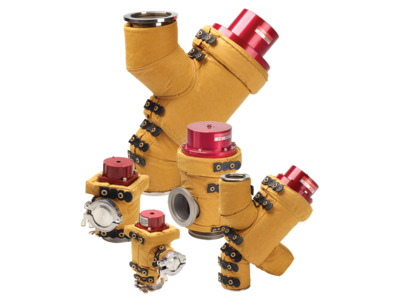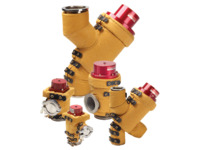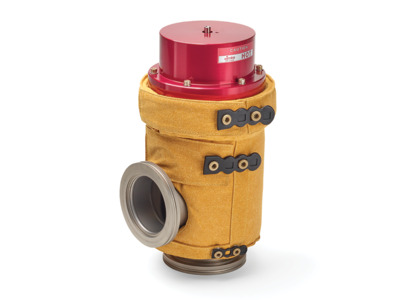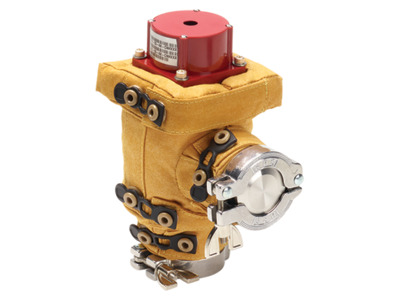- Products
- Pressure Controllers and Valves
- Valves
- Vacuum Isolation Valves
- Jalapeño Heated Vacuum Isolation Valves
Jalapeño Heated Vacuum Isolation Valves

Jalapeño Heated Vacuum Isolation Valves
Overview
Jalapeño Vacuum Valves are specifically designed to withstand high internal temperatures to limit process by-product buildup and reduce system maintenance. The valves are specially designed with a thermal barrier between the actuator and the stainless-steel housing, insulating the internal wetted surfaces, greatly improving thermal performance. The Jalapeño Series has a separate thermal barrier located between the valve housing and the valve body. The valves feature spring-to-close, air-to-open pneumatic operation and are available in port diameters ranging from 1 inch to 4 inches. The MKS Jalapeño LoPro™ Series actuator cap is made entirely of a high-quality polymer to provide a superior thermal barrier for the valve housing.
- Maintains optimal valve conductance ensuring materials don’t solidify and clog the system
- Actuator thermal barrier design improves internal thermal performance and reduces external temperature to safe touch levels
- Formed bellows-sealed poppet valve reduces particle trapping resulting in high cycle life See All Features
Products
Configuration Options
The Jalapeño vacuum valves can be configured/ordered with or without heater jackets, and Jalapeño valve heater jackets can also be ordered separately.
See the Jalapeño Heated Vacuum Isolation Valve datasheet for all product options.
heated-isolation-valves - Drawings & CAD
Additional CAD file downloads are not available for this product.
heated-isolation-valves - Drawings
Additional drawings are not available for this product.
Features
Jalapeño Standard & LoPro Valves
Jalapeño Standard Isolation Valves are available in sizes ranging from NW50 - NW100. These valves are suitable for general vacuum isolation where maximum conductance and reliable operation is required. Jalapeño Standard Isolation Valves are also available as two-stage designs with an integrated bypass valve that can be used for soft-pumping.
Jalapeño LoPro Low-profile Isolation Valves are available in sizes ranging from NW25 - NW50. The compact Jalapeño LoPro design, like our unheated LoPro Valves, provides 1,000,000 cycle life operation, a more compact form factor, and a simplified disassembly process for ease of service. Both the Jalapeño Standard and Jalapeño LoPro valves are available in NW50 size.
For applications where high cycle life is desired Jalapeño LoPro is recommended. For all other applications, Jalapeño Standard is a suitable option.
Jalapeño Thermal Management System
The Jalapeño Vacuum Valves are heated with MKS' Series 49UL Thermal Management System. The heater has a set point temperature of 170°C and typically reaches set point temperature in less than 30 minutes. The heaters can be daisy-chained with integral locking connectors and are available in either polyimide or PTFE-woven materials. The heaters are wired in parallel and independently controlled. A power cord is required for every 10 amps drawn by a chain of heaters.
The S49UL Thermal Management System provides a complete, integrated Thermal Heater Solution for multiple and custom applications.
Specifications
Jalapeño Standard & LoPro Valve Specifications
|
Main Valve |
ByPass Valve |
|
|---|---|---|
| Vacuum Range | Atmosphere to below 10-9 Torr | Atmosphere to below 10-9 Torr |
| Helium Leak Rate | Less than 1.0 x 10-9 std cc/sec | Less than 1.0 x 10-9 std cc/sec |
| Cylinder Air Pressure | 60-100 psig | 60-120 psig |
| Limit Switch Rating, Single Pole, Double Through | 5A, 250VAC/5A, 30VDC | n/a |
| Pneumatic Cylinder Displacement Volume | n/a | 0.25 in.3 (4.1 cm3) |
| Approximate Pneumatic Closing Time | n/a | 100 msec |
| Blow-By Pressure | n/a | 47 psia |
| Maximum Internal Spring Closing Pressure | n/a | 40 psia |
Jalapeño Standard Valve Specifications
|
Port Size |
Actuator Cylinder Volume |
Actuation Opening/Closing Time |
Blow By Pressure |
Maximium Internal Spring Closing Pressure |
|---|---|---|---|---|
| 2.0 in. (NW50) | 13.3 in.3(218 cm3) | 1,000/2,000 msec | 45 psia | 38 psia |
| 3.0 in. (NW80) | 27.6 in.3(453 cm3) | 2,000/2,000 msec | 38 psia | 40 psia |
| 4.0 in. (NW100) | 27.6 in.3(453 cm3) | 2,000/2,000 msec | 30 psia | 30 psia |
Jalapeño LoPro Valve Specifications
|
Port Size |
Actuator Cylinder Volume |
Actuation Opening/Closing Time at 100 psi |
Blow By Pressure |
Maximium Internal Spring Closing Pressure |
|---|---|---|---|---|
| 1.0 in. (NW25) | 1.2 in.3(20 cm3) | 40/90 msec | 80 psia | 43 psia |
| 1.5 in. (NW40) | 2.2 in.3(36 cm3) | 60/90 msec | 50 psia | 60 psia |
| 2.0 in. (NW50) | 6.4 in.3(105 cm3) | 160/220 msec | 45 psia | 38 psia |
Features
Jalapeño Standard & LoPro Valves
Jalapeño Standard Isolation Valves are available in sizes ranging from NW50 - NW100. These valves are suitable for general vacuum isolation where maximum conductance and reliable operation is required. Jalapeño Standard Isolation Valves are also available as two-stage designs with an integrated bypass valve that can be used for soft-pumping.
Jalapeño LoPro Low-profile Isolation Valves are available in sizes ranging from NW25 - NW50. The compact Jalapeño LoPro design, like our unheated LoPro Valves, provides 1,000,000 cycle life operation, a more compact form factor, and a simplified disassembly process for ease of service. Both the Jalapeño Standard and Jalapeño LoPro valves are available in NW50 size.
For applications where high cycle life is desired Jalapeño LoPro is recommended. For all other applications, Jalapeño Standard is a suitable option.
Jalapeño Thermal Management System
The Jalapeño Vacuum Valves are heated with MKS' Series 49UL Thermal Management System. The heater has a set point temperature of 170°C and typically reaches set point temperature in less than 30 minutes. The heaters can be daisy-chained with integral locking connectors and are available in either polyimide or PTFE-woven materials. The heaters are wired in parallel and independently controlled. A power cord is required for every 10 amps drawn by a chain of heaters.
The S49UL Thermal Management System provides a complete, integrated Thermal Heater Solution for multiple and custom applications.
Specifications
Jalapeño Standard & LoPro Valve Specifications
|
Main Valve |
ByPass Valve |
|
|---|---|---|
| Vacuum Range | Atmosphere to below 10-9 Torr | Atmosphere to below 10-9 Torr |
| Helium Leak Rate | Less than 1.0 x 10-9 std cc/sec | Less than 1.0 x 10-9 std cc/sec |
| Cylinder Air Pressure | 60-100 psig | 60-120 psig |
| Limit Switch Rating, Single Pole, Double Through | 5A, 250VAC/5A, 30VDC | n/a |
| Pneumatic Cylinder Displacement Volume | n/a | 0.25 in.3 (4.1 cm3) |
| Approximate Pneumatic Closing Time | n/a | 100 msec |
| Blow-By Pressure | n/a | 47 psia |
| Maximum Internal Spring Closing Pressure | n/a | 40 psia |
Jalapeño Standard Valve Specifications
|
Port Size |
Actuator Cylinder Volume |
Actuation Opening/Closing Time |
Blow By Pressure |
Maximium Internal Spring Closing Pressure |
|---|---|---|---|---|
| 2.0 in. (NW50) | 13.3 in.3(218 cm3) | 1,000/2,000 msec | 45 psia | 38 psia |
| 3.0 in. (NW80) | 27.6 in.3(453 cm3) | 2,000/2,000 msec | 38 psia | 40 psia |
| 4.0 in. (NW100) | 27.6 in.3(453 cm3) | 2,000/2,000 msec | 30 psia | 30 psia |
Jalapeño LoPro Valve Specifications
|
Port Size |
Actuator Cylinder Volume |
Actuation Opening/Closing Time at 100 psi |
Blow By Pressure |
Maximium Internal Spring Closing Pressure |
|---|---|---|---|---|
| 1.0 in. (NW25) | 1.2 in.3(20 cm3) | 40/90 msec | 80 psia | 43 psia |
| 1.5 in. (NW40) | 2.2 in.3(36 cm3) | 60/90 msec | 50 psia | 60 psia |
| 2.0 in. (NW50) | 6.4 in.3(105 cm3) | 160/220 msec | 45 psia | 38 psia |
Accessories
Jalapeño S49UL Heater Power Kits
| Compare | Description | Compatibility | Drawings, CAD & Specs | Avail. | Price | |||
|---|---|---|---|---|---|---|---|---|
 |
20021379-001 Power Kit, fits Series 49UL Heater Jacket, 8 ft. 120 VAC Cable and Series 49UL Power Adapter | UNIVERSAL | $166 |
|
||||
 |
20021381-001 Power Kit, fits Series 49UL Heater Jacket, 8 ft. 240 VAC Cable and Series 49UL Power Adapter | UNIVERSAL | $166 |
|
||||
 |
20021380-001 Power Kit, fits Series 49UL Heater Jacket, 15 ft. 120 VAC Cable and Series 49UL Power Adapter | UNIVERSAL | $166 |
|
||||
 |
20021382-001 Power Kit, fits Series 49UL Heater Jacket, 15 ft. 240 VAC Cable and Series 49UL Power Adapter | UNIVERSAL | $166 |
|
Jalapeño Heater Communications Kits
| Compare | Description | Compatibility | Drawings, CAD & Specs | Avail. | Price | |||
|---|---|---|---|---|---|---|---|---|
 |
20014265-001 Communications Kit, Series 49UL Heaters, Includes Communication Cable and USB Adapter | UNIVERSAL | $166 |
|
||||
 |
20015929-001 Communication Kit, Series 49UL Heater, 50 ft. Flying Leads & S49UL Connector | UNIVERSAL | $173 |
|
Jalapeño Heater Accessories
| Compare | Description | Compatibility | Drawings, CAD & Specs | Avail. | Price | |||
|---|---|---|---|---|---|---|---|---|
 |
501999-0211 Slow Pump Insulator, PTFE | UNIVERSAL |
5 Weeks
|
$419 |
|
|||
 |
502999-0417 Slow Pump Insulator, Polyimide | UNIVERSAL |
5 Weeks
|
$375 |
|
|||
 |
20018033-001 Large Replacement Heater Speed Straps | UNIVERSAL |
5 Weeks
|
$13.23 |
|
|||
 |
20002133 Replacement Heater Speed Straps | UNIVERSAL | $13.23 |
|
||||
 |
20003387 Controller to Controller Extension Cable, 12 inch | UNIVERSAL | $56 |
|
||||
 |
20003388 Controller to Controller Extension Cable, 24 inch | UNIVERSAL | $61 |
|
||||
 |
20003389 Controller to Controller Extension Cable, 36 inch | UNIVERSAL | $67 |
|
||||
 |
20003390 Controller to Controller Extension Cable, 48 inch | UNIVERSAL | $73 |
|
||||
 |
20003610 Controller to Controller Extension Cable, 120 inch | UNIVERSAL | $95 |
|
||||
 |
20007170-001 Controller to Controller Extension Cable, 300 inch | UNIVERSAL | $446 |
|
||||
 |
20008474-001 Heater to Controller Extension Cable, 12 inch | UNIVERSAL | $101 |
|
||||
 |
20008476-001 Heater to Controller Extension Cable, 24 inch | UNIVERSAL | $129 |
|
||||
 |
20008477-001 Heater to Controller Extension Cable, 36 inch | UNIVERSAL | $158 |
|
||||
 |
20008478-001 Heater to Controller Extension Cable, 48 inch | UNIVERSAL | $186 |
|
Jalapeño Standard Valve Spare Parts
| Compare | Description | Compatibility | Drawings, CAD & Specs | Avail. | Price | |||
|---|---|---|---|---|---|---|---|---|
 |
100010658 Main Valve Rebuild Kit, Chemraz & Viton Seals, Jalapeño Valve, NW50 | UNIVERSAL | $1,059 |
|
||||
 |
100010656 Main Valve Rebuild Kit, Chemraz & Viton Seals, Jalapeño Valves, NW80 | UNIVERSAL |
4 Weeks

|
$1,675 |
|
|||
 |
100010654 Main Valve Rebuild Kit, Chemraz & Viton Seals, Jalapeño Valves, NW100 | UNIVERSAL | $1,737 |
|
||||
 |
100010659 Main Valve Rebuild Kit with Chemraz Seal Set, Jalapeño Valves, NW50 | UNIVERSAL | $1,434 |
|
||||
 |
100010657 Main Valve Rebuild Kit with Chemraz Seal Set, Jalapeño Valves, NW80 | UNIVERSAL | $1,847 |
|
||||
 |
100010655 Rebuild Kit, Valve Internals, Chemraz Seals, Jalapeño Heated Main Valve, NW100 | UNIVERSAL | $2,234 |
|
||||
 |
100001683 Limit Switch Kit, 150, 160, V-100, 2-stage Pneumatic Valves, NW50 or NW63 | UNIVERSAL |
4 Weeks
|
$120 |
|
|||
 |
100001684 Limit Switch Kit, 150, 160, V-100, 2-stage Pneumatic Valves, NW80 | UNIVERSAL |
4 Weeks
|
$120 |
|
|||
 |
100003663 Limit Switch Kit, 150, 160, V-100, 2-stage Pneumatic Valves, NW100 | UNIVERSAL |
4 Weeks
|
$130 |
|
|||
 |
100010643 Chemraz and Viton Seal Set, Jalapeño Heated Main Valve, NW50 Port | UNIVERSAL | $240 |
|
||||
 |
100010645 Chemraz and Viton Seal Set, Jalapeño Heated Main Valve, NW80 Port | UNIVERSAL | $350 |
|
||||
 |
100010647 Chemraz and Viton Seal Set, Jalapeño Heated Main Valve, NW100 Port | UNIVERSAL | $546 |
|
||||
 |
100010642 Chemraz Seal Set, for Jalapeño Heated Main Valve, NW50 Port | UNIVERSAL | $580 |
|
||||
 |
100010644 Chemraz Seal Set, for Jalapeño Heated Main Valve, NW80 Port | UNIVERSAL | $845 |
|
||||
 |
100010646 Chemraz Seal Set, for Jalapeño Heated Main Valve, NW100 Port | UNIVERSAL | $1,269 |
|
Jalapeño Bypass Valve Spare Parts
| Compare | Description | Compatibility | Drawings, CAD & Specs | Avail. | Price | |||
|---|---|---|---|---|---|---|---|---|
 |
100010652 Bypass Valve Rebuild Kit, Viton & Chemraz Seals, Jalapeño Valves | UNIVERSAL |
4 Weeks

|
$360 |
|
|||
 |
100010653 Valve Rebuild Kit, Viton & Chemraz Seals, Jalapeño Bypass Valve | UNIVERSAL |
4 Weeks

|
$365 |
|
|||
 |
100010650 Bypass Valve Rebuild Kit with Chemraz Seal Set, Jalapeño Valves | UNIVERSAL |
4 Weeks

|
$480 |
|
|||
 |
100010651 Bypass Valve Rebuild Kit with Chemraz Seal Set, Jalapeño Manual Valves | UNIVERSAL | $499 |
|
||||
 |
100010649 Chemraz & Viton Seal Set, Jalapeño Valve Bypass Stage | UNIVERSAL |
4 Weeks

|
$72 |
|
|||
 |
100010648 Chemraz Seal Set, Jalapeño Bypass Valve | UNIVERSAL | $172 |
|
Jalapeño LoPro Valve Spare Parts
| Compare | Description | Compatibility | Drawings, CAD & Specs | Avail. | Price | |||
|---|---|---|---|---|---|---|---|---|
 |
100010666 Valve Rebuild Kit, Chemraz & Viton Seals, Jalapeño LoPro Valves, NW25 | UNIVERSAL | $811 |
|
||||
 |
100010667 Valve Rebuild Kit, Chemraz & Viton Seals, Jalapeño LoPro Valves, NW40 | UNIVERSAL |
4 Weeks
|
$860 |
|
|||
 |
100010668 Valve Rebuild Kit, Chemraz & Viton Seals, Jalapeño LoPro Valves, NW50 | UNIVERSAL | $1,087 |
|
||||
 |
100010554 Valve Rebuild Kit with Chemraz Seal Set, Jalapeño LoPro Valves, NW25 | UNIVERSAL | $1,131 |
|
||||
 |
100010555 Valve Rebuild Kit with Chemraz Seal Set, Jalapeño LoPro Valves, NW40 | UNIVERSAL | $684 |
|
||||
 |
100010556 Valve Rebuild Kit with Chemraz Seal Set, Jalapeño LoPro Valves, NW50 | UNIVERSAL | $1,600 |
|
||||
 |
100010154 Limit Switch Kit, Jalapeño LoPro Valves, NW25 | UNIVERSAL |
4 Weeks
|
$220 |
|
|||
 |
100010155 Limit Switch Kit, Jalapeño LoPro Valves, NW40 | UNIVERSAL |
4 Weeks
|
$155 |
|
|||
 |
100010156 Limit Switch Kit, Jalapeño LoPro Valves, NW50 | UNIVERSAL |
4 Weeks
|
$155 |
|
|||
 |
100010662 Chemraz and Viton Seal Set, Jalapeño LoPro Valve, NW25 Port | UNIVERSAL | $144 |
|
||||
 |
100010663 Chemraz and Viton Seal Set, Jalapeño LoPro Valve, NW40 Port | UNIVERSAL |
4 Weeks
|
$188 |
|
|||
 |
100010664 Chemraz and Viton Seal Set, Jalapeño LoPro Valve, NW50 Port | UNIVERSAL | $227 |
|
||||
 |
100010557 Chemraz Seal Set, Jalapeño LoPro Valve, NW25 Port | UNIVERSAL | $370 |
|
||||
 |
100010558 Chemraz Seal Set, Jalapeño LoPro Valve, NW40 Port | UNIVERSAL | $470 |
|
||||
 |
100010559 Chemraz Seal Set, Jalapeño LoPro Valve, NW50 Port | UNIVERSAL | $569 |
|
Jalapeño Replacement Solenoid Valves
| Compare | Description | Compatibility | Drawings, CAD & Specs | Avail. | Price | |||
|---|---|---|---|---|---|---|---|---|
 |
100008539 Solenoid Valve, Replacement, 12 VDC, 7 Watt | UNIVERSAL |
14 Weeks

|
$105 |
|
|||
 |
100008163 Solenoid Valve, Replacement, 24 VDC, 7 Watt | UNIVERSAL |
14 Weeks
|
$153 |
|
|||
 |
100008164 Solenoid Valve, Replacement, 24 VAC, 50-60 Hz, 6 Watt | UNIVERSAL |
14 Weeks

|
$200 |
|
|||
 |
1062179 Replacement Solenoid Valve, 100 VAC 50/60 Hz, 6.8 Watts | UNIVERSAL |
14 Weeks
|
|
||||
 |
100008165 Replacement Solenoid Valve, 120 VAC, 50-60 Hz, 7.5 Watt | UNIVERSAL |
14 Weeks

|
$195 |
|
|||
 |
100008166 Solenoid Valve, Replacement, 208 VAC, 50-60 Hz, 7.5 Watt | UNIVERSAL |
14 Weeks

|
$145 |
|
|||
 |
100008167 Solenoid Valve, Replacement, 220-240 VAC, 50-60 Hz, 7.5 Watt | UNIVERSAL |
14 Weeks

|
$170 |
|
Resources
Literature
- Jalapeño Heated Vacuum Isolation Valves (4.5 MB, PDF)
Resources
Literature
- Jalapeño Heated Vacuum Isolation Valves (4.5 MB, PDF)





 Ultra-High Velocity
Ultra-High Velocity